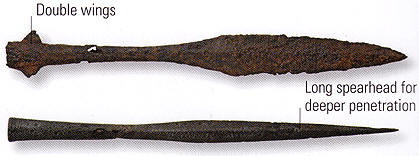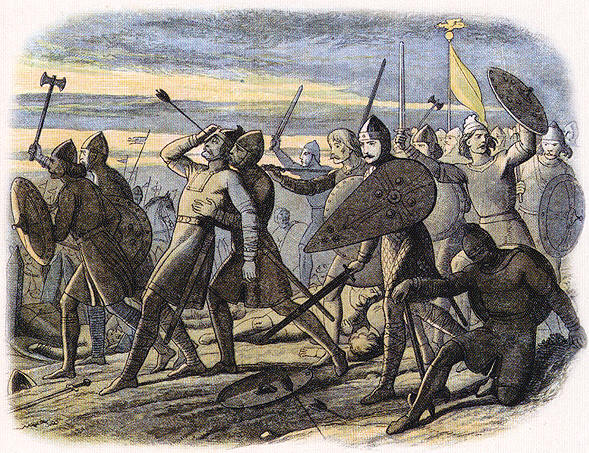Saxon Weapons
Around AD400, the Saxons came
to England with a reputation for warlike ferocity
and a strong reverence for the sword as a potent
symbol of both strength and martial spirit. The mass
of Anglo-Saxon warriors normally carried a shield
and dagger (seax) and fought with spears and axes.
More sophisticated members of the nobility and
professional soldiers carried spears (similar to the
Roman pilum) and swords.
The Saxon Sword
Through excavating
numerous graves in England, archaeologists have
learnt that the Anglo-Saxons often chose to bury
their dead with a full array of weapons and armour.
These grave weapons are normally of great beauty and
artistry, highlighting the belief that a warrior
needed to take with him into the afterlife (or in
later Christianized Anglo-Saxon society
—
heaven), material
proof of the great status afforded to its owner
while alive.
Ownership of both
sword and spear defined the Anglo-Saxon warrior as a
free man, compared with slaves (oeows) who were
forbidden from carrying any arms. The great cost of
acquiring a serviceable sword would also have shown
the owner to be a man of means and rank. A typical
Anglo-Saxon sword had a long, straight, double-edged
blade with an average length of around 90cm
(35.4in).
The Saxon Spear
In Anglo-Saxon
burial grounds, the spear is by far the most common
type of weapon unearthed and is regarded as the
primary armament of the Anglo-Saxon warrior. All
ranks of society carried the spear, from king and
eon (earl), to the lowly ceonl (free man of the
lowest rank) or conscripted peasant. Comprising a
leaf- shaped iron spearhead and wooden shaft,
traditionally made of ash, a typical spear measured
around 1.5—2.5m (4.9—8.2ft) in length.

ABOVE:
In
a detail from the Bayeux Tapestry,
1082,
the English soldiers, who are all on foot, protect
themselves with a shield wall while the Normans
mount a cavalry attack.
The spear would have
been held in one hand while a shield was grasped in
the other. It was extremely effective when used in a
mass formation, most notably the famous Anglo-Saxon
“shieldwall” or shildburh. It was this shildburh
that faced William the Conqueror at the Battle of
Hastings. It was only compromised when the Normans
feigned a cavalry retreat, deliberately allowing
themselves to be chased, whereupon they suddenly
wheeled back and charged the openly exposed
Anglo-Saxons. This was a fatal error by the pursuers
and dictated the eventual outcome of the battle.
In contemporary
descriptions of the Battle of Maldon in AD991
(situated on the modern-day Essex coast in England),
the Anglo-Saxon Eon Byrhtnoth is depicted as
throwing two types of spear or javelin, both long
and short. It is interesting that it was only when
injured by a Viking spear, and finally exhausting
his supplies of spears, that he eventually resorts
to using his sword.

ABOVE:
A
winged Saxon spearhead (top) with double wings to
prevent an opponent’s blade traveling down the
spear. A slim spearhead (bottom) to allow
penetration through armor.
The Saxon
Battle-axe
Anglo-Saxon
warriors inherited the two-handed “bearded”
battle-axe from earlier generations of Danish Viking
invaders who had employed it with great effect to
board enemy ships. The Anglo-Saxons soon became
extremely proficient at using the battle- axe. With
its 1 .2m (3.9ft) haft and large honed axehead of
around 30cm (11 .8in), it had the capacity to
shatter shields and inflict grievous wounds. Swung
from side to side, it could cut down a mounted
soldier and his horse in a single blow.
These long axes
were wielded by the huscarls (King Harold’s personal
bodyguards) and described as cleaving “both man and
horse in two”. One of the drawbacks of using the
two-handed axe is that while raised above the head
it momentarily left the user dangerously exposed at
the front to sword or lance thrusts. Despite this,
the sight of a mass of axe- wielding Anglo-Saxon
warriors approaching the enemy’s ranks normally had
the desired psychological effect, with many
contemporary accounts noting that the opposition
simply fled from the battlefield.

ABOVE:
A
later depiction of the felling of King Harold II (c.1022—1066)
by a Norman arrow at the Battle of Hastings (1066).
Anglo-Saxon Women
Warriors
It was not only men
who fought and became respected heroes during the
Anglo-Saxon period. Recent archaeological
discoveries have raised the possibility that women
also took part in warfare.
In the village of
Heslerton, in North Yorkshire, England, two female
burials were unearthed in 2000. Dated to around
AD450—650, both women had been buried with spears
and knives. Just outside Lincoln, a town in eastern
England, the skeleton of another Anglo-Saxon woman
warrior
(c.
AD500) was found
with a dagger and shield.
Procopius
(c.AD500—565),
the late Roman Byzantine scholar, notes in his
history of the Gothic Wars (AD535—552) that an
unnamed Anglo-Saxon princess, from the tribe of
Angilori and described as “the Island Girl”, led an
invasion of Jutland (western Denmark) and captured
the German King Radigis of the Varni.
Aethelflaed, eldest
daughter of Alfred the Great of England
(c.
AD849—899), was
known as the Lady of Mercia and was at the forefront
of many battles against the invading Vikings.
Aethelflaed was also responsible for the
construction of a number of Anglo-Saxon
fortifications.
The Sutton Hoo
Sword
The sword is part of
a magnificent hoard of royal Anglo- Saxon treasures
found in a huge ship grave, in Suffolk, England, in
1939; its design is based on the earlier Roman
spatha, or cavalry sword. Its decoration includes a
hilt comprising a beautiful gold and cloisonné
garnet pommel and gold cross guard. The iron blade
is heavily corroded but the original pattern welding
is still identifiable and includes eight bundles of
thin iron rods hammered together to form the
pattern. This would have given the sword exceptional
strength, although it is more likely that it was
produced solely as a sumptuous grave gift.
|